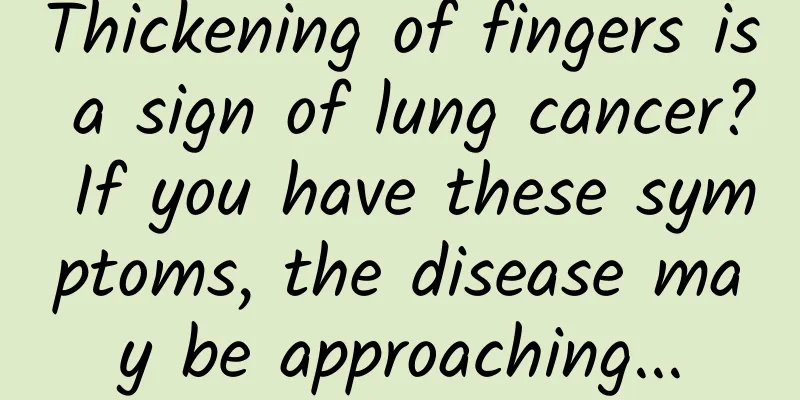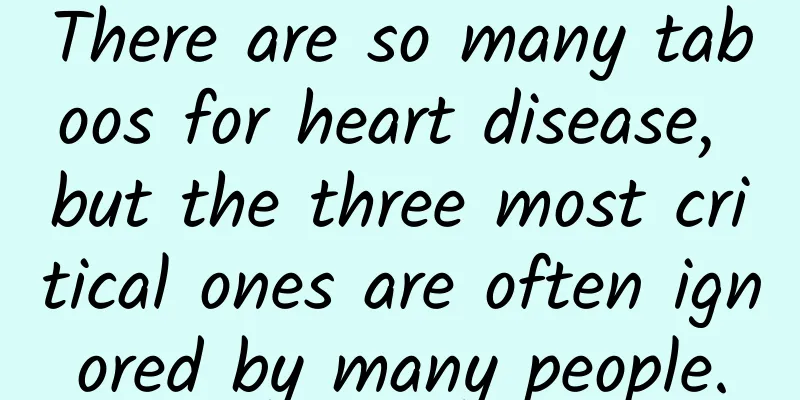Thickening of fingers is a sign of lung cancer? If you have these symptoms, the disease may be approaching...

|
Expert of this article: Wang Qian, attending physician, Department of Infectious Diseases, First Hospital of Hebei Medical University This article was reviewed by Li Jiangtao, Associate Chief Physician, Department of Respiratory and Critical Care Medicine, Hebei Chest Hospital Do you often pay attention to the changes in your hands? Most people may care about whether their fingers are slender and whether their nails are neat and clean... These do affect the beauty of our hands, but sometimes they also indicate the arrival of some diseases. Recently, a woman in Guangdong found some changes in her hands. Her fingers and toes became thicker and thicker, but because there were no other obvious symptoms, she did not pay much attention to it. By chance, she met a doctor, who suggested that she go to the hospital for a check-up as soon as possible. Weibo screenshot After medical examination, the woman was found to have a tumor of about 4 centimeters in her lung, and the doctor diagnosed it as lung cancer. Why is it that changes in the fingers are related to lung cancer? What is the problem with such swelling at the end of the fingers? Let's take a look at what is going on today. What is finger clubbing? The thickening of the fingertips is medically known as clubbing, which is defined as: the finger (toe) is enlarged and appears drumstick-shaped or the base angle between the proximal end of the nail and the soft tissue of the nail root is ≥180 degrees. In clinical practice, clubbing of fingers is more common than that of toes. Finger clubbing is a metabolic disorder caused by chronic hypoxia and long-term anoxia in the body. Hypoxia causes the capillaries of the distal limbs to dilate. Due to the abundant blood flow at the distal end, painless proliferation of soft tissue is obvious, eventually forming acromegaly and the distal knuckles become thicker and swollen, which is called finger clubbing. Why do people with lung cancer develop finger clubbing? For patients with lung cancer, the tumor compresses the airway and blood vessels, and the body is in a state of chronic hypoxia. If not treated for a long time, clubbing of the fingers may occur. What diseases might clubbing indicate? There are many reasons that can lead to clubbing of fingers. 75-80% are caused by lung diseases, 10-15% are caused by cardiovascular diseases, and other diseases and genetics also account for a certain proportion. The most common clinical clubbing that should be vigilant is mainly the following: Copyright image, no permission to reprint If finger clubbing occurs in middle-aged or older people, or if there is a history of long-term heavy smoking, or if there is a history of lung cancer in the immediate family, and if there is chest pain, hemoptysis, or coughing due to unknown causes, you should be highly alert to lung cancer and should seek medical attention from the respiratory department or thoracic surgery department in a timely manner. If accompanied by long-term chronic cough, spitting up a lot of purulent sputum, repeated hemoptysis or blood in sputum, be alert to lung infectious diseases such as bronchiectasis, lung abscess, etc., it is recommended to see a respiratory department; If the clubbing occurs at an early age, accompanied by cyanosis of the lips and hypoxia, and squatting phenomenon (a forced posture in which the child bends his legs and squats for a while while walking or playing, and then resumes normal walking), it is considered that there may be congenital heart disease, and cardiology and cardiac surgery should be consulted; If accompanied by long-term intermittent fever, splenomegaly, skin hemorrhages, and embolism in the limbs, be alert to infective endocarditis, which is a very serious infection and requires immediate cardiology hospitalization; Clubbing is relatively rare in digestive system diseases, but when it is combined with viral hepatitis or long-term heavy drinking, ascites, varicose veins in the abdomen, and jaundice of the body, one should be alert to cirrhosis. How to self-diagnose whether you have finger clubbing? Since finger clubbing has so many implications for us, how do we check ourselves to see if we have finger clubbing? The first method: Place the backs of the middle fingers of both hands together, and bring the end finger joints and fingers together. If there is a small diamond-shaped gap between the bases of the two fingers, it is normal; if the gap becomes smaller or disappears, it may be clubbing. If accompanied by the above discomfort, you need to see a doctor in time. The second method: the superior angle measurement method. On the front of the finger, there is a base angle between the nail surface and the skin at the end. For normal people, this angle is less than 160 degrees, but for clubbed fingers, this angle is often greater than 180 degrees. What should I do if I notice finger clubbing? First of all, we need to clarify a concept: the presence of clubbing does not mean that the disease has been diagnosed. Clubbing itself is relatively common. Many people have clubbing, and they do not feel uncomfortable. Complete examinations have not found any related diseases. In this case, we do not need to worry too much. The appearance of clubbing may indicate some diseases, and examinations are necessary when necessary. Copyright image, no permission to reprint In clinical practice, the treatment of clubbing is still based on the primary disease. When you find yourself with clubbing, you need to consider whether you have other physical discomforts, such as coughing, spitting, hemoptysis, chest tightness, chest pain, etc. in the respiratory system, whether you have precordial pain in the heart, whether you have bleeding spots in the body, and other common discomfort symptoms mentioned above. Go to the relevant department for treatment, complete the necessary examinations, and carry out corresponding treatment according to the cause. Do not do too much treatment for the clubbed fingers themselves. The watermarked images and cover images in this article are from the copyright gallery, and the image content is not authorized for reprinting |
>>: Why did the first patient who received clinical treatment with penicillin die?
Recommend
Summary of Google I/O Conference Content | The most exciting thing this year is artificial intelligence!
Welcome to the Google I/O Developer Conference, t...
iMessage's Emoji bug has existed for multiple versions
Recently, Apple iOS has been exposed to various b...
Does hair dye cause cancer? What is the difference between hair dyes that cost tens of dollars and hundreds of dollars?
When dyeing their hair, many people often look fo...
Is there hope? Rumor has it that AirPods wireless headphones will go on sale next week
On the morning of November 11, it was reported th...
What is the difference between "single sampling" and "mixed sampling" for nucleic acid testing? One picture to understand
Source: Beijing Daily Client...
How to promote user conversion? 99% of them used this trick~
Today, I want to share with you a trick to promot...
How to optimize PPC (pay-per-click) strategy in overseas promotion?
PPC is simply the abbreviation of Pay Per Click, ...
Foreign media: Apple's performance in 2016 was really not very good
According to foreign media reports, after a one o...
What are the benefits of promoting WeChat mini programs?
1. Mini Programs combined with official accounts ...
Understand the subtext and chat to make the opposite sex more welcoming and attractive to you
Understand the subtext and chat to make the oppos...
Which servers are generally used for live streaming?
Which servers are generally used by live streamin...
When exploring an extraterrestrial planet, does the probe fly in a straight line? Learn more about the Hohmann transfer orbit
In "Elements" written by the ancient Gr...
Youtube video marketing and keyword search!
Four major benefits of YouTube video marketing : ...
Apple Watch vs. LG G Watch Urbane
When it comes to watches, we have seen all kinds ...
New research: Are the sugar-free drinks we drink every day actually "attacking" our blood vessels?
In today's society where health awareness is ...








![[In-depth Analysis] How to create information flow advertising materials for adult education?](/upload/images/67cc36f8e990c.webp)
